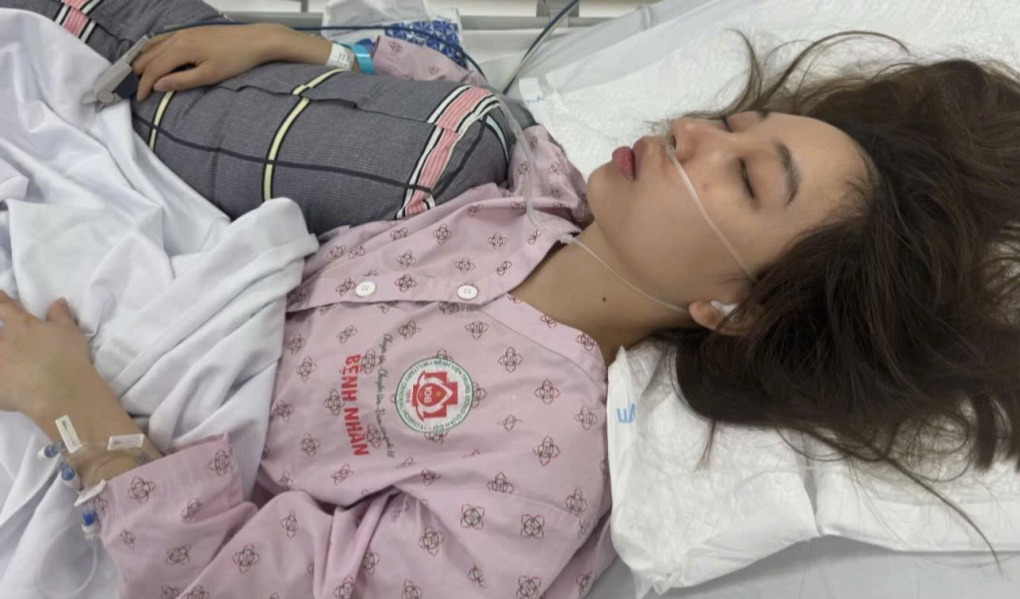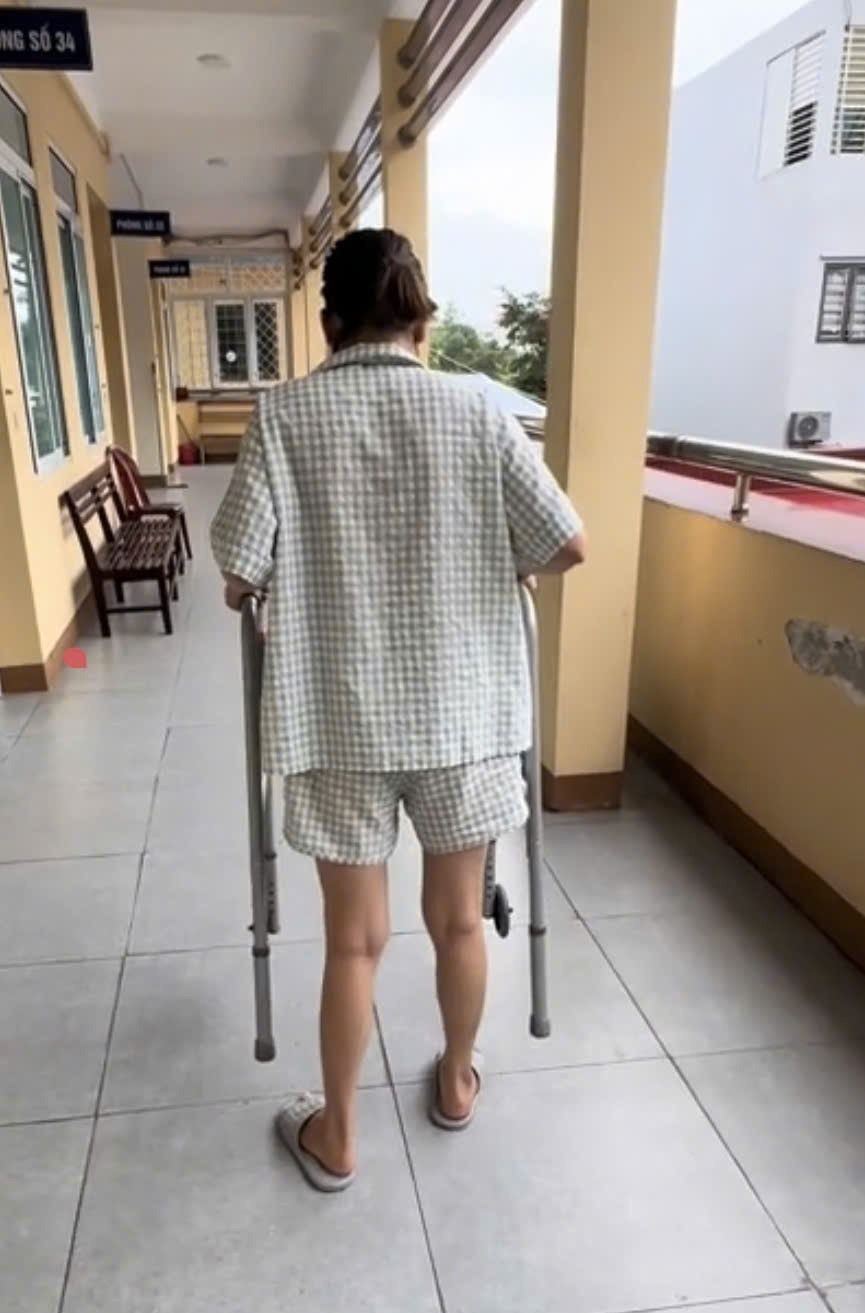Khanh Linh suddenly experienced a severe, splitting headache and lost consciousness while seated at her desk after lunch on June 12. An hou...

Khanh Linh suddenly experienced a severe, splitting headache and lost consciousness while seated at her desk after lunch on June 12.
An hour later, medical professionals at a hospital in Thai Nguyen determined that the 28-year-old had suffered a stroke resulting from a ruptured brain aneurysm because of a congenital blood vessel abnormality.
Her health was severe, and she was promptly taken to 108 Military Central Hospital in Hanoi for urgent surgery five months ago. "I don't recall anything from that week," Linh says.
Whatever she knows about that era is learned from family members who remained with her. She had a contemporary endovascular surgical procedure that cost several hundred million dong (VND100 million = $3,800).
 |
| Khanh Linh during her treatment at Military Central Hospital 108 in Hanoi. Photo provided by Khanh Linh |
After surgery, Linh faced a difficult recoverynext steps. She remained at Military Central Hospital 108 for over 20 days prior to going back home to start her recovery process.
She states: "Five months on, my mouth remains asymmetrical, causing difficulty in speaking, and my left eye is still unable to close completely. My body is still weak, and I am unable to walk independently, requiring constant assistance."
She suffered from facial paralysis after the stroke, which made even basic tasks challenging. Her mouth remains open, and saliva flows freely.
She states, "At that moment, I required two individuals to look after me. One would remain by my side simply to wipe away the"saliva."
Her mother and sister alternated in remaining at her side.
At first, Linh needed to use a feeding tube. The mix of exhaustion and difficulty eating led to a quick weight loss, going from 47 or 48 kg down to only 40 kg. Now, following extensive therapy, she has gradually gained back some weight.
 |
| Khanh Linh receives physical therapy at a hospital in Thai Nguyen. Photo provided by Khanh Linh. |
Prior to the stroke, her life appeared entirely ordinary, with the exception of a slight headache a few days before, which she attributed to the shifting weather.
"Previously, I had many unhealthy routines like staying up late, missing meals, and feeling stressed due to work," she mentions.
In retrospect, she thinks her way of living might have played a role in her worsening health.
"In the initial months, I experienced very negative thoughts," she acknowledges.
The sense of powerlessness, the perception of being a burden to her family, and anxiety about the future led her to a state of hopelessness.
A systematic review featured in the British medical journalThe Lancetdiscovered that roughly one-third of individuals who have had a stroke experience depression within the initial five years.
It proposed that depression following a stroke is not merely a psychological response but also connected to physical damage in brain regions responsible for regulating emotions.
This ailment hinders both mental and bodily recovery and raises the likelihood of mortality.
For young patients such as Linh, the psychological impact can be even more intense. A sudden stroke may take away career advancements, self-reliance, and social security, resulting in a profound sense of identity loss.
"My family brought me back," Linh says.
Her mother and sister were consistently by her side, offering not only practical assistance but also emotional encouragement.
When I fell apart, they would remain quiet and take my hand. Their tolerance and selfless affection made me understand that I was not by myself.
She also developed her own "mental health treatment plan." She started sharing brief videos on TikTok to track her progress in recovery.
Initially, it was only a personal recovery journal, but over time, messages of support and shared experiences from readers turned into an unexpected source of motivation. "When I realized my story could assist others, this battle suddenly became significant," she states.
Transforming her trauma into a message of awareness allowed her to change her perspective from being a patient to becoming a source of inspiration. Each day, she adheres to a rigorous rehabilitation routine, which includes acupuncture, acupressure, and walking exercises using a balance frame.
Every step, staying a few seconds longer, cycling one additional full turn, is considered a success. "I'm beginning to value the tiniest things, ones I used to overlook," she states.
 |
| Khanh Linh prior to the stroke. Photo provided by Khanh Linh |
Another study published in The Lancetindicates that the incidence of strokes among individuals under 45 has increased notably across the globe in recent years. The World Health Organization reports that approximately 15% of present-day stroke cases affect this age group.
Moreover, the figure is rising quickly, particularly in rapidly expanding city regions.
In Vietnam, the Ministry of Health estimates that 5–7% of all stroke cases are among patients younger than 45, with higher percentages observed in major cities such as Hanoi and Ho Chi Minh City. The reasons includelinked to modern lifestyles: long-term stress, unhealthy eating, lack of physical activity, and pre-existing health issues like high blood pressure, obesity, and diabetes, which often remain undetected in young adults.
As stated by Dr. Hoang Tien Trong Nghia, head of the Neurology Department at Military Hospital 175, congenital vascular anomalies such as Linh's condition are particularly risky since they typically do not exhibit any signs until a blood vessel bursts.
To enhance early identification, the World Stroke Organization suggests using the F.A.S.T. method, which involves checking for facial drooping, arm weakness, and unclear speech, and emphasizes the importance of contacting emergency services right away.



